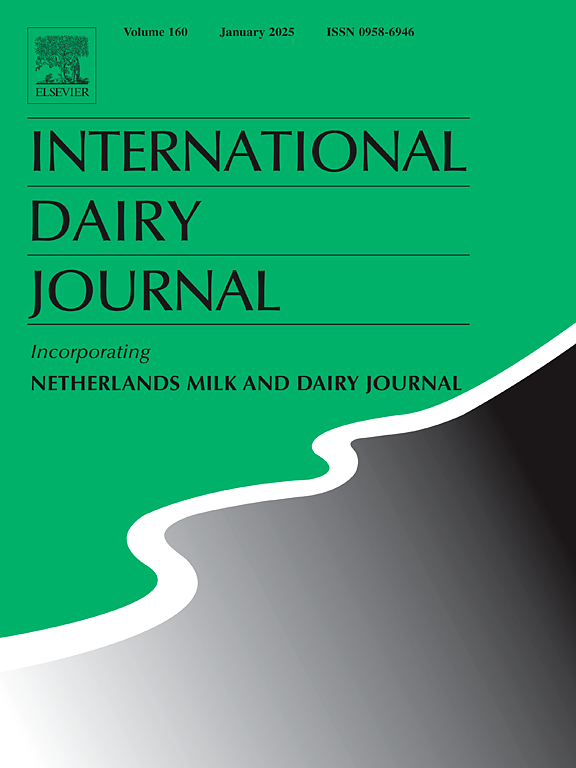酶解磷酸化对纯化牛酪蛋白体外消化的影响
IF 3.4
3区 农林科学
Q2 FOOD SCIENCE & TECHNOLOGY
引用次数: 0
摘要
本实验研究了去磷酸化对牛α - s-酪蛋白(αs1+αs2)和β-酪蛋白体外消化率的影响。利用牛碱性磷酸酶可产生三种磷酸化状态:完全磷酸化(天然)、部分去磷酸化(αs1: 65%、αs2: 35%、β: 60%)和完全去磷酸化(αs1: 0%、αs2: 25%、β: 0%)。采用INFOGEST 2.0方案评估消化率,采用邻苯二醛法测定水解度(DH), LC-ESI/MS Single Q法跟踪完整酪蛋白的分解。结果表明,α -酪蛋白和β-酪蛋白的去磷酸化在胃期和肠期均增加DH。α - s-酪蛋白在不同磷酸化状态下的DH发育差异显著,在胃期和肠期均有发现。与此同时,部分去磷酸化和完全去磷酸化的β-酪蛋白之间没有显著差异。这些结果表明,去磷酸化提高了酪蛋白的消化率,并且与β-酪蛋白相比,α - s-酪蛋白的消化率更为明显。本文章由计算机程序翻译,如有差异,请以英文原文为准。
Effect of enzymatic dephosphorylation on in vitro digestion of purified bovine caseins
This study investigated the impact of dephosphorylation on the in vitro digestibility of bovine αs-caseins (αs1+αs2) and β-caseins. Three phosphorylation states were generated using bovine alkaline phosphatase: fully phosphorylated (native), partly dephosphorylated (αs1: 65 %, αs2: 35 %, β: 60 %), and fully dephosphorylated (αs1: 0 %, αs2: 25 %, β: 0 %). Digestibility was assessed using the INFOGEST 2.0 protocol, which employed the O-phthaldialdehyde assay to measure the degree of hydrolysis (DH) and LC-ESI/MS Single Q to track the breakdown of intact caseins. Results showed that dephosphorylation of αs-casein and β-caseins increased DH during both gastric and intestinal phases. For αs-caseins, DH development differed significantly among all phosphorylation states, which were found in both gastric and intestinal phases. At the same time, no significant differences were observed between partially and fully dephosphorylated β-caseins. These findings indicate that dephosphorylation increases the digestibility of caseins and is more pronounced in the digestibility of αs-casein compared to β-casein.
求助全文
通过发布文献求助,成功后即可免费获取论文全文。
去求助
来源期刊

International Dairy Journal
工程技术-食品科技
CiteScore
6.50
自引率
9.70%
发文量
200
审稿时长
49 days
期刊介绍:
The International Dairy Journal publishes significant advancements in dairy science and technology in the form of research articles and critical reviews that are of relevance to the broader international dairy community. Within this scope, research on the science and technology of milk and dairy products and the nutritional and health aspects of dairy foods are included; the journal pays particular attention to applied research and its interface with the dairy industry.
The journal''s coverage includes the following, where directly applicable to dairy science and technology:
• Chemistry and physico-chemical properties of milk constituents
• Microbiology, food safety, enzymology, biotechnology
• Processing and engineering
• Emulsion science, food structure, and texture
• Raw material quality and effect on relevant products
• Flavour and off-flavour development
• Technological functionality and applications of dairy ingredients
• Sensory and consumer sciences
• Nutrition and substantiation of human health implications of milk components or dairy products
International Dairy Journal does not publish papers related to milk production, animal health and other aspects of on-farm milk production unless there is a clear relationship to dairy technology, human health or final product quality.
 求助内容:
求助内容: 应助结果提醒方式:
应助结果提醒方式:


